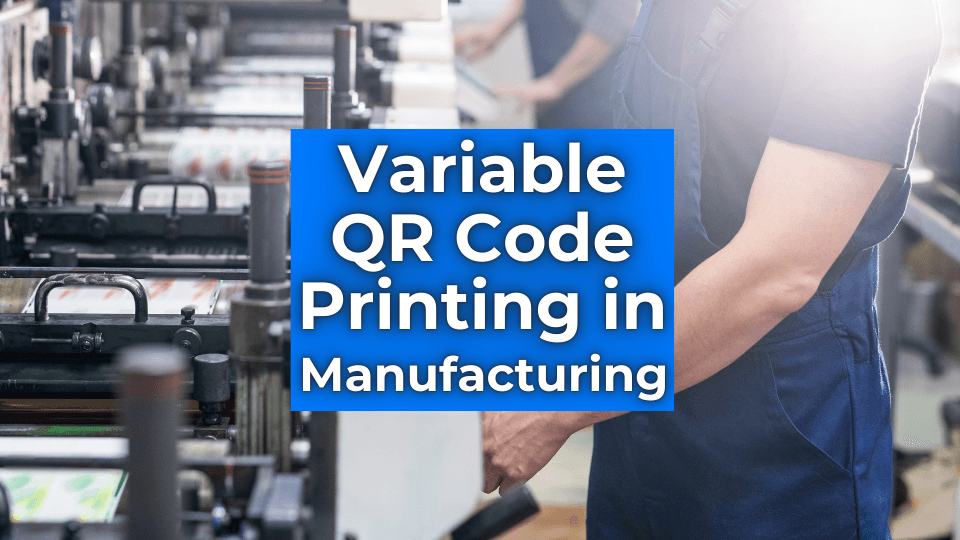Variable QR Code Printing and Why Is It Revolutionizing Manufacturing?

All the Manufacturing industries are undergoing a digital transformation, and Variable QR Code Printing is at the forefront of this change. Unlike static QR codes, variable QR codes are unique and dynamically generated for individual products or packages. These codes are reshaping how manufacturers manage production, track inventory, engage consumers, and safeguard against counterfeiting.
What Are Variable QR Codes?
Variable QR codes are unique codes printed directly on each product or package during manufacturing. They store dynamic, individualized information such as:
- Serial numbers
- Batch information
- Expiry dates
- Supply chain tracking data
- Product-specific URLs
These codes allow manufacturers to embed and access customized data at scale, revolutionizing traceability and interactivity.
- Editable Content: The destination or data linked to the QR code can be updated without changing the physical code.
- Unique Identifiers: Each code can be assigned a unique identity, enabling product-level differentiation.
- Advanced Analytics: Tracks user interactions, such as scan location, time, and device type.
- Integration with Supply Chains: Seamlessly integrates with inventory systems for real-time tracking and traceability.
Example Applications
- Tracking product movement across the supply chain.
- Providing personalized user experiences, such as loyalty programs or authentication.
- Offering product-specific details, like batch information or expiry dates.
The Key Benefits of Variable QR Code Printing on Product Packaging
Enhanced Product Traceability
- Track products from production to delivery.
- Identify specific batches in case of recalls or quality checks.
- Reduce inefficiencies and risks in the supply chain.
Anti-Counterfeiting Measure
- Authenticate products through unique QR codes.
- Allow customers to verify authenticity using smartphones.
- Provide real-time data on counterfeit activity.
Personalized Consumer Engagement
- Use QR codes to share product-specific content like user manuals, recipes, or tutorials.
- Enable consumers to participate in loyalty programs.
- Collect feedback or reviews directly from end-users.
Sustainability Friendly
- Reduce paper waste by embedding detailed product information in the QR code.
- Enable digital receipts and warranty claims, lowering the need for physical documentation.
Regulatory Compliance
- Meet industry-specific regulations requiring product traceability (e.g., pharmaceuticals, food and beverage).
- Provide detailed information for recalls or audits.
Efficiency in Logistics
- Streamline inventory management with real-time scanning.
- Improve warehouse accuracy and reduce human errors.
- Accelerate shipment processing with digital tracking.

Applications of Variable QR Code Printing in Manufacturing
Pharmaceutical Industry
- Variable QR codes ensure compliance with serialization laws like the Drug Supply Chain Security Act (DSCSA) in the U.S. and the Falsified Medicines Directive (FMD) in the EU.
- Enhance patient safety by providing drug authentication and dosage details.
Food and Beverage
- Enable traceability from farm to fork.
- Prevent contamination by identifying problematic batches quickly.
- Provide transparency about sourcing and sustainability practices.
Electronics
- Improve after-sales services with product-specific QR codes for warranties and repair tracking.
- Facilitate component traceability in complex supply chains.
Luxury Goods
- Protect brand integrity by combating counterfeits.
- Allow customers to validate authenticity and provenance using QR codes.
Automotive
- Track individual parts and assemblies throughout their lifecycle.
- Simplify product recalls and repairs with detailed part history.
Variable QR Codes vs. Static QR Codes: What’s the Difference?
QR codes have become a vital tool for product packaging, offering a seamless way to connect customers with information, promotions, and brand stories. However, not all QR codes are created equal. The choice between variable QR codes and static QR codes can significantly impact functionality and user experience, particularly in product packaging.
What are Static QR Codes?
Static QR codes contain fixed information that cannot be changed after the code is generated. These codes are widely used for simple, unchanging content like URLs or contact details.
Key Characteristics of Static QR Codes
- Uneditable Content: The information is hardcoded into the QR code and cannot be updated or modified.
- Simple Use Cases: Ideal for applications like linking to websites, social media, or basic product details.
- Low Implementation Cost: Easy to create without requiring sophisticated infrastructure.
- Limited Tracking: Static QR codes lack analytics capabilities, making them unsuitable for data-driven campaigns.
Example Applications
- A QR code linking to a product manual.
- Coupons or discounts for a specific campaign.
- Brand websites for general information.
Why Choose Variable QR Codes for Product Packaging?
- Enhanced Traceability
- Real-Time Updates
- Personalization
- Anti-Counterfeiting Measures
- Data-Driven Insights
Static QR Codes vs. Variable QR Codes: A Quick Comparison
Feature | Static QR Codes | Variable QR Codes |
Content | Fixed, uneditable | Dynamic, editable |
Personalization | Not possible | Highly customizable |
Tracking & Analytics | Limited or none | Advanced insights available |
Integration with Systems | Basic | Seamless with supply chains |
Cost | Lower upfront cost | Requires infrastructure |
Use Cases | Simple, one-size-fits-all | Tailored, scalable solutions |
Choosing the Right QR Code for Your Packaging
The choice between static and variable QR codes depends on your brand's goals and the complexity of your supply chain. While static QR codes are sufficient for straightforward applications, variable QR codes unlock advanced capabilities, enabling personalization, traceability, and anti-counterfeiting measures.
For product packaging, where customer engagement and supply chain transparency are increasingly critical, variable QR codes offer a versatile and future-proof solution.

The Technology Behind Variable QR Code Printing
The creation and implementation of variable QR codes rely on advanced technologies:
- Digital Printing: Allows on-demand and dynamic printing of QR codes during production.
- Cloud Integration: Links QR codes to real-time databases for live tracking and updates.
- Blockchain: Ensures the security and immutability of data stored within QR code systems.
- IoT Integration: Connects products to the broader ecosystem for enhanced visibility and management.
Why Variable QR Codes Are Revolutionizing Manufacturing
Customization at Scale
- The ability to personalize every product with unique data opens new possibilities for mass customization.
Data-Driven Insights
- By analysing scanned QR code data, manufacturers can gain insights into consumer behaviour, geographic trends, and supply chain inefficiencies.
Cost Efficiency
- Reduce costs associated with recalls, counterfeiting, and inefficiencies.
- Streamline operations with digital data management.
Consumer Trust
- Empower consumers with transparency and interactivity, fostering stronger brand loyalty.
Future Outlook
As industries embrace smart manufacturing, variable QR codes will become integral to the production and supply chain process. With advancements in technologies like AI and IoT, these codes will drive more intelligent and connected ecosystems, bridging the gap between manufacturers and consumers.
Variable QR code printing is not just a tool; it is a transformative solution reshaping the very fabric of manufacturing in a connected world.
Leverage Acviss Technology for Packaging Innovation
With Acviss's cutting-edge solutions, incorporating variable QR codes into your product packaging in production line in a very seamless manner. Empower your brand with traceability, enhanced customer engagement, and anti-counterfeiting tools tailored to meet the demands of today’s dynamic market.